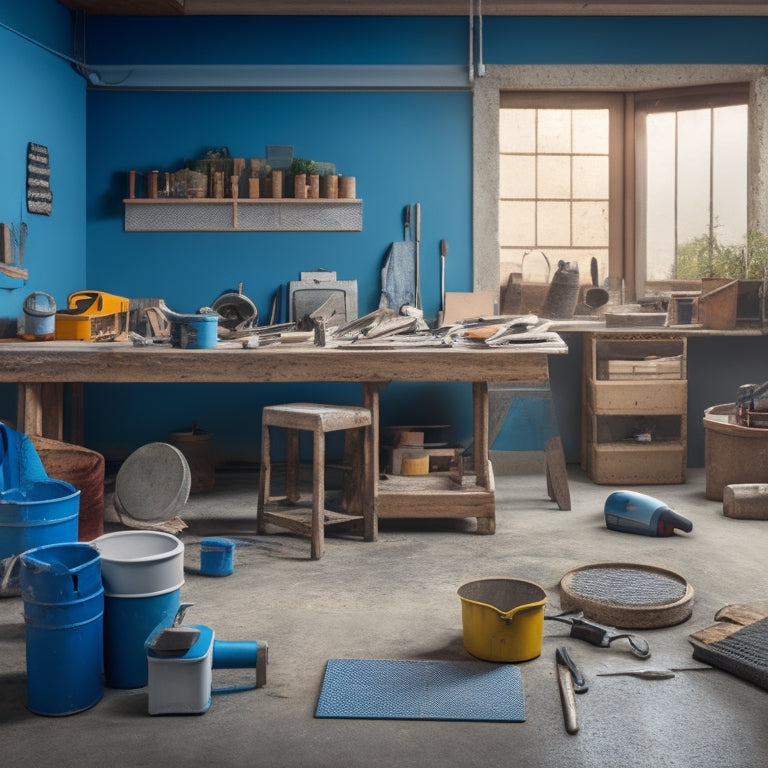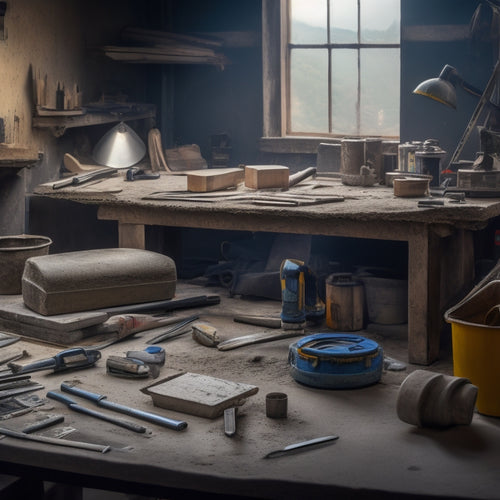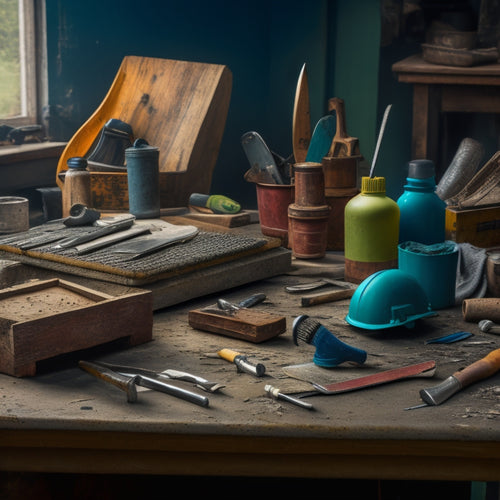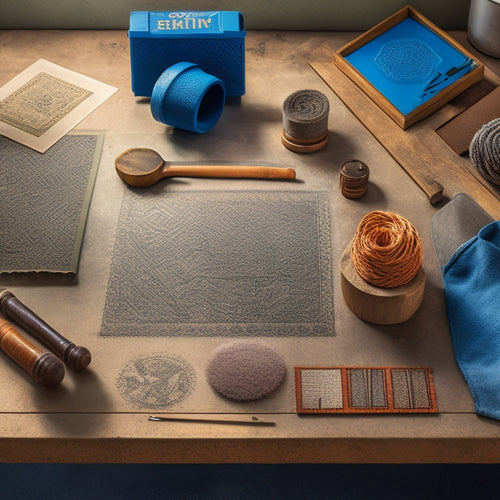
Top Tools for Concrete Tile Adhesive Application
Share
When applying concrete tile adhesive, you'll need the right tools to guarantee a strong, long-lasting bond. Start with notched trowels for even adhesive spreading, and adhesive spreaders for uniform coverage. Mixing paddles will help you blend the adhesive efficiently, while grout floats and scraper blades will come in handy for post-application cleanup. Leveling tools, spacers, and edging tools will also be essential for achieving a professional-looking finish. By investing in these top tools, you'll be well on your way to a successful installation - and that's just the beginning of the process.
Key Takeaways
• Notched trowels and adhesive spreaders are essential for even and accurate concrete tile adhesive application.
• Mixing paddles ensure thorough blending of the adhesive, and their selection depends on mixing techniques and materials.
• Grout floats and scraper blades are crucial for post-adhesive application and removing excess adhesive for a smooth surface.
• Leveling tools, such as spirit levels and laser levels, ensure a smooth and even substrate surface for adhesive application.
• Spacers and edging tools are vital for maintaining consistent gaps and clean cuts between concrete tiles, enhancing the overall aesthetic.
Notched Trowels for Adhesive Application
You'll need a notched trowel to apply the concrete tile adhesive, as it allows for the correct amount of adhesive to be spread evenly and accurately onto the substrate. This tool is vital for achieving a successful bond between the tile and the surface.
When choosing a notched trowel, consider the type of adhesive you're using, as different notches are designed for specific adhesive types. For example, a U-notched trowel is ideal for epoxy-based adhesives, while a V-notched trowel is better suited for cement-based adhesives.
Mastering trowel techniques is essential for a professional-looking finish. Hold the trowel at a 45-degree angle and press it firmly onto the substrate, spreading the adhesive in a consistent, even layer. Use long, smooth strokes to cover the entire area, working in sections to maintain control.
Grout Floats for Smooth Finishing
After applying the concrete tile adhesive and allowing it to set, a grout float becomes an essential tool for achieving a smooth, even finish. It does this by pressing excess grout into the gaps between tiles and removing any excess material from the surface.
You'll want to choose a grout float that's suitable for your specific project, considering factors like the size and type of tiles, as well as the grout color selection. A rubber-edged float is ideal for smaller, more intricate grout joints, while a metal-edged float is better suited for larger joints.
When using a grout float, it's vital to hold it at a 45-degree angle and press it firmly into the grout joints to remove excess material. This will help you achieve a consistent, even finish.
Additionally, make sure to use the float in a sweeping motion, working in sections to maintain control and avoid spreading grout unevenly. By mastering grout joint techniques and using a high-quality grout float, you'll be able to achieve professional-looking results that will last for years to come.
Mixing Paddles for Fast Blending
When preparing concrete tile adhesive, a mixing paddle becomes an indispensable tool for fast and thorough blending of the mixture, ensuring a consistent and reliable bond between the tile and the substrate.
You'll want to choose a paddle that suits your specific needs, considering factors like mixing techniques and paddle materials.
Here are three key considerations for selecting the right mixing paddle:
-
Paddle material: Opt for a paddle made from durable, rust-resistant materials like stainless steel or fiberglass. These will withstand the rigors of heavy mixing and last longer.
-
Blade design: A paddle with curved or angled blades will help you achieve a smoother, more uniform mix. This is especially important when working with thick or viscous adhesives.
-
Handle ergonomics: Look for a paddle with a comfortable, non-slip grip that fits your hand well. This will reduce fatigue and improve control during extended mixing sessions.
Adhesive Spreaders for Even Coverage
With your mixed adhesive ready, you're now set to apply it evenly to the substrate, and that's where an adhesive spreader comes in, helping you achieve uniform coverage and a strong bond between the tile and the surface.
The spreader's notched or toothed edge guarantees the adhesive is applied at the correct thickness, usually between 1/8 inch and 1/4 inch, depending on the manufacturer's recommendations. This consistent adhesive thickness is vital for a strong bond and to prevent lippage or uneven tile installation.
When choosing an adhesive spreader, consider the type of adhesive you're using and the substrate material. Some spreaders are designed for specific adhesive types or substrate materials, so make sure to select the right one for your project.
Additionally, develop good application techniques to guarantee even coverage. Hold the spreader at a 45-degree angle and apply the adhesive in a continuous, sweeping motion, working in sections to maintain even coverage.
Edging Tools for Clean Cuts
When you're working with concrete tile adhesive, achieving clean cuts around edges is essential for a professional-looking finish.
To get the job done, you'll need edging tools that provide precise edge control, allowing you to make accurate cuts with confidence.
Precise Edge Control
You'll achieve precise edge control and clean cuts by utilizing specialized edging tools designed specifically for concrete tile adhesive applications. These tools guarantee a professional finish by preventing excess adhesive from oozing out beyond the tile edges.
To achieve precise edge control, follow these essential steps:
-
Edge Sealing: Use a high-quality edge sealer to create a barrier between the tile and the surrounding surface. This prevents adhesive from seeping behind the tile and guarantees a clean finish.
-
Surface Preparation: Properly prepare the surface by cleaning and degreasing it to guarantee a strong bond between the tile and adhesive.
-
Clean Cuts: Utilize a precision edging tool to make clean cuts around obstructions, such as pipes or corners, guaranteeing a seamless finish.
Smooth Cut Finish
Smooth Cut Finish
For a smooth cut finish, select an edging tool that's designed to make precise, curved cuts around obstructions, allowing you to achieve a seamless joint where the tile meets the surrounding surface. This is essential in concrete tile adhesive application, as it guarantees a strong bond between the tile and the substrate. With the right edging tool, you can create a clean, professional-looking finish that enhances the overall aesthetic of the installation.
When choosing an edging tool, consider the following factors:
| Tool Type | Cutting Style | Ideal for |
|---|---|---|
| Diamond-edged | Aggressive, straight cuts | Removing old adhesive or preparing rough surfaces |
| Carbide-tipped | Precise, curved cuts | Cutting around obstructions, such as pipes or electrical outlets |
| Oscillating multi-tool | Versatile, angled cuts | Tile surface preparation and adhesive drying time-sensitive applications |
| Rotary cutter | Fast, straight cuts | Large-scale tile installations, where speed is essential |
| Hand-held nippers | Delicate, curved cuts | Trimming tile edges or making precise cuts in tight spaces |
Leveling Tools for Perfect Alignment
To guarantee a professional-looking installation, start by using a spirit level to check the substrate's surface for any deviations from the desired plane. Even slight inaccuracies can lead to lippage and uneven tile layout. This vital step in tile substrate preparation guarantees a solid foundation for your concrete tile adhesive application.
Next, you'll need to address any irregularities you've identified. Here are three essential leveling tools to get the job done:
-
Laser level: Projects a level line or plane onto the substrate, allowing you to identify and correct deviations with ease.
-
Self-leveling compound: A specialized mixture that fills gaps and imperfections, creating a smooth, even surface for adhesive application.
-
Tamping tool: A handheld device used to compact and level the substrate, guaranteeing a solid bond between the concrete tile and adhesive.
Spacers for Consistent Gaps
With the substrate properly leveled, guaranteeing consistent gaps between concrete tiles is essential, as it directly impacts the overall aesthetic and functionality of the installation.
You'll want to achieve uniform gaps to prevent lippage, guarantee proper drainage, and create a visually appealing finish. To achieve this, you'll need spacers specifically designed for concrete tile adhesive application.
These spacers come in various thicknesses, allowing you to control the gap width with precision. You can choose from plastic or metal spacers, depending on your specific needs. When selecting spacers, consider the type of tile, substrate, and adhesive you're using, as well as the environmental conditions of the installation site.
To guarantee accurate gap measurement, use gap measurement tools, such as feeler gauges or digital calipers, to verify the spacer's thickness. This will help you maintain consistent gaps throughout the installation.
Scraper Blades for Removing Excess
Scraper Blades for Removing Excess
Frequently, you'll find that excess concrete tile adhesive accumulates between the tiles, and scraper blades are essential for removing this excess material efficiently. This step is critical in tile surface preparation, as any remaining adhesive can affect the final appearance and longevity of the installation.
When selecting a scraper blade, consider the following factors:
-
Blade material: Choose a blade made from a durable, rust-resistant material that can withstand the rigors of scraping and cleaning.
-
Blade width: Select a blade with a width that matches the gap between your tiles, ensuring efficient removal of excess adhesive.
-
Blade angle: Opt for a blade with an adjustable angle, allowing you to customize the scraping action to suit your specific needs.
Frequently Asked Questions
How Often Should I Clean My Notched Trowel During Application?
You should clean your notched trowel every 10-15 minutes during application to maintain ideal adhesive consistency, as dried adhesive can affect its spreadability, and regular trowel maintenance guarantees a smooth, even finish.
Can I Use a Grout Float for Mixing Small Amounts of Adhesive?
When you're in a pinch, you might wonder if that trusty grout float can moonlight as a mixing tool for small adhesive batches - and, surprisingly, its versatility can make it a decent makeshift option for certain adhesive mixing techniques.
Are Mixing Paddles Suitable for Mixing Other Types of Materials?
You're wondering if mixing paddles are suitable for mixing other materials beyond adhesive. They can be, depending on the mixing techniques and paddle materials used, but it's essential to take into account the specific material's requirements and compatibility.
Do Adhesive Spreaders Work Well With Epoxy-Based Adhesives?
You'll find that adhesive spreaders work well with epoxy-based adhesives if they're compatible, but viscosity matters; thicker epoxies may require specialized spreaders or adjusted techniques to guarantee even application and ideal bond strength.
Can I Reuse Scraper Blades After Cleaning and Sharpening Them?
You can extend the life of scraper blades by maintaining them properly; after cleaning and sharpening, inspect for damage, and re-use them for adhesive application techniques, ensuring peak performance and minimizing waste.
Conclusion
As you step back to admire your handiwork, you're met with a sea of perfectly aligned concrete tiles, their adhesive bonds strong and uniform.
The notched trowels, grout floats, and mixing paddles have become trusty extensions of your skilled hands, working in harmony to create a masterpiece.
With every gap precisely spaced and every cut clean, your tile installation is a demonstration to the power of the right tools in the right hands.
Related Posts
-

3 Best Hand Tools for DIY Concrete Construction
When tackling a DIY concrete construction project, you'll need three essential hand tools to achieve a professional-l...
-

Must-Have Handheld Tools for Concrete Repair
When tackling a concrete repair project, it is crucial to have the right handheld tools to achieve a professional fin...
-

5 Best Tools for Stamping Concrete Walls
When it comes to stamping concrete walls, you'll need a range of specialized tools to achieve the desired texture and...


